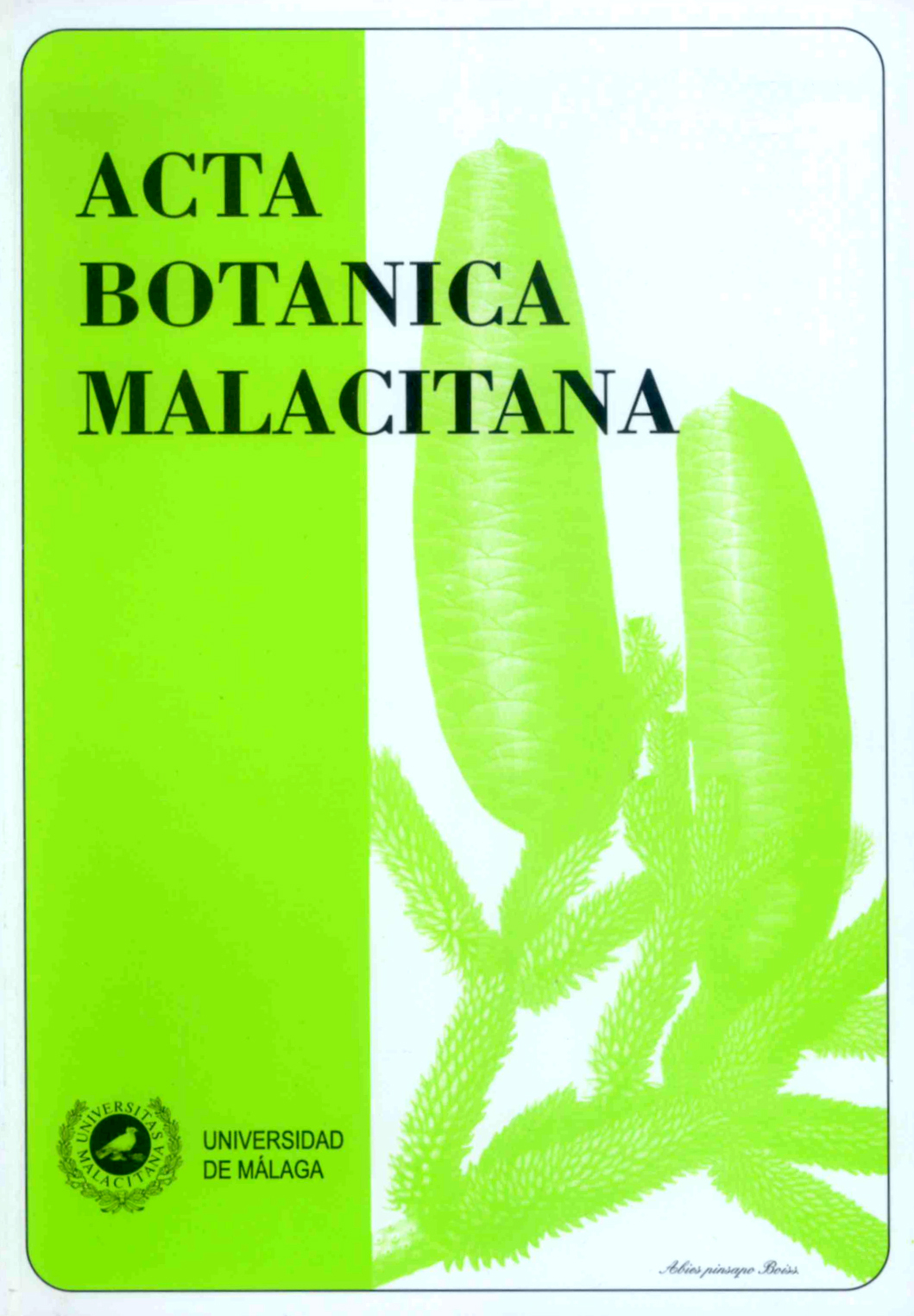Vegetación del sector malacitano-axarquiense (Comarca de la Axarquía. Montes de Málaga y Corredor de Colmenar). Málaga (España).
DOI:
https://doi.org/10.24310/abm.v33i0.6981Abstract
RESUMEN. Vegetación del sector Malacitano-Axarquiense (Comarca de La Axarquía, Montes de
Málaga y Corredor de Colmenar). Málaga (España). Se ha realizado un estudio fitocenológico,
florístico y fitogeográfico del sector Malacitano-Axarquiense (provincia Bética, Región Mediterránea),
que coincide en gran medida con la comarca natural de la Axarquía, Montes de Málaga y Corredor de
Colmenar (provincia de Málaga, Andalucía, España). Bioclimáticamente aparecen los pisos
termomediterráneo seco y subhúmedo y el piso mesomediterráneo subhúmedo. Se propone una
sectorización fitogeográfica a un nivel inferior al de sector, con 5 unidades: unidad Axarquiense (la
más oriental), unidad Montes de Málaga (la de mayor elevación y precipitación anual), unidad Almogía
(la más occidental), unidad Hacho de Pizarra (geomorfológicamente aislada) y unidad Corredor de
Colmenar (al norte de las anteriores). Se han recolectado algunos táxones de interés por su grado de
amenaza, por estar protegidos, por ser endemismos o muy escasos. El territorio presenta una elevada
cantidad de sintaxones (85) si tenemos en cuenta que ha sufrido una fuerte antropización por la
influencia de la ciudad de Málaga y por la gran extensión de cultivos marginales. De estos sintaxones
destacan algunas novedades como un tipo de alcornocal (Centaureo sempervirentis-Quercetum suberis)
o una alianza de pastizales vivaces otoñales (Ranunculion bullati). Se han catalogado 13 series de
vegetación: 4 de tipo climatófilo caracterizadas por vegetación climácica de árboles planifolios
(Quercus rotundifolia, Quercus suber); 6 edafohidrófilas con vegetación climácica dominada por
árboles caducifolios (Populus alba, Ulmus minor, Fraxinus angustifolia) o arbustos de riberas o niveles
freáticos (Salix pedicellata, Neirum oleander, Tamarix africana); 3 edafoxerófilas caracterizadas
climácicamente por arbustos relictuales (Maytenus senegalensis, Juniperus turbinata) o árboles (Olea
sylvestris). La vegetación de complejos edafogénicos se desarrolla en suelos con niveles freáticos
(Coriaria myrtifolia), lagunas (hidrófitos), dunas y arenales (psammófitos) y acantilados litorales
(Limonium malacitanum). Se aportan en este trabajo el esquema sintaxonómico, los inventarios y/o
tablas fitosociológicas de novedades o interés especial y un mapa fitogeográfico.
Palabras clave. Vegetación, fitogeografía, sintaxonomía, Montes de Málaga, Axarquía, Málaga,
Andalucía, España.
SUMMARY. Vegetation of the Axarquia, Montes de Malaga and Colmenar Corridor (Malacitano-
Axarquiense phytogeographical sector) Málaga (Spain). A series of phytocoenological, floristic and
phytogeographical studies have been made in the Malacitano-Axarquiense sector (Betica province,
Mediterranean region) that corresponds to the local territories of Axarquía, Montes de Málaga and
Corredor de Colmenar (Malaga province, Andalusia, Spain). The bioclimatic belts of the studied
territory are thermomediterranean dry and subhumid and mesomediterranean subhumid. The proposed
phytogeographical division under sector level delimits 5 units: Axarquiense (eastern most), Montes
de Málaga (the highest and with higher rainfall), Almogía (western most), Hacho de Pizarra
(lithologically isolated) and Corredor de Colmenar (located at the north of the others). Some interesting
plants have been pointed out due to its endangered status or being protected by law, endemics or rare.
In the studied territory develop a large number of sintaxa (85) if we consider that the land has suffered
a strong man influence (large expanse of dry-farmed crops) and it is very near to the city of Málaga.
Some sintaxa stand out: a new type of Quercus suber forest (Centaureo sempervirentis-Quercetum
suberis) and a new alliance for autumnal geophyte grasslands (Ranunculion bullati). A total amount
of 13 vegetation series have been catalogued: 4 series are climactic and characterised by sclerophyll
broad-leaved trees (Quercus rotundifolia, Quercus suber); 6 edaphohydrophyllic series with climax
characterised by deciduous trees (Populus alba, Ulmus minor, Fraxinus angustifolia) or tall shrubs
(Salix pedicellata, Neirum oleander, Tamarix africana) in riversides or underground water tables; 3
edaphoxerophyllic series characterised by relict shrublands (Maytenus senegalensis, Juniperus
turbinata) or trees (Olea sylvestris). The vegetation that develops in mosaic-complexes corresponds
to damp soils (Coriaria myrtifolia), pools (hydrophytes), dunes and sandy areas (psammophytes) and
coastal cliffs (Limonium malacitanum). This work includes a syntaxonomical scheme, relevés or
tables for interesting new phytosociological sintaxa and a phytogeographical map.
Key words. Vegetation, Phytogeography, sintaxonomy, Montes de Málaga, Axarquía, Malaga,
Andalusia, Spain.
Downloads
Metrics
Downloads
Published
How to Cite
Issue
Section
License
Those authors who publish in this journal accept the following terms:
a. The authors will retain their copyrights and guarantee the journal the right of first publication of their work, which will be simultaneously subject to the Creative Commons Attribution-Non-commercial 4.0 license whose full text can be found at <http: // creative commons .org / licenses / by-nc / 4.0> that allows third parties to share the work as long as its author and its first publication are indicated, and as long as it is not for commercial purposes.
b. Authors may adopt other non-exclusive licensing agreements for the distribution of the version of the published paper (e.g., deposit it in an institutional telematic file or publish it in a monographic volume) provided that the initial publication in this journal be indicated.
c. Authors are allowed and recommended to disseminate their work through the Internet (e.g., in institutional telematic archives or on their websites) before and during the submission process, which can produce interesting exchanges and increase citations of the published work. (See The effect of open access)







1.png)
